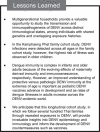An Innovative, Prospective, Hybrid Cohort-Cluster Study Design to Characterize Dengue Virus Transmission in Multigenerational Households in Kamphaeng Phet, Thailand
- PMID: 31971570
- PMCID: PMC7393304
- DOI: 10.1093/aje/kwaa008
An Innovative, Prospective, Hybrid Cohort-Cluster Study Design to Characterize Dengue Virus Transmission in Multigenerational Households in Kamphaeng Phet, Thailand
Erratum in
-
RE: ``AN INNOVATIVE, PROSPECTIVE, HYBRID COHORT-CLUSTER STUDY DESIGN TO CHARACTERIZE DENGUE VIRUS TRANSMISSION IN MULTIGENERATIONAL HOUSEHOLDS IN KAMPHAENG PHET, THAILAND''.Am J Epidemiol. 2021 Aug 1;190(8):1703. doi: 10.1093/aje/kwab122. Am J Epidemiol. 2021. PMID: 34100893 Free PMC article. No abstract available.
Abstract
Difficulties inherent in the identification of immune correlates of protection or severe disease have challenged the development and evaluation of dengue vaccines. There persist substantial gaps in knowledge about the complex effects of age and sequential dengue virus (DENV) exposures on these correlations. To address these gaps, we were conducting a novel family-based cohort-cluster study for DENV transmission in Kamphaeng Phet, Thailand. The study began in 2015 and is funded until at least 2023. As of May 2019, 2,870 individuals in 485 families were actively enrolled. The families comprise at least 1 child born into the study as a newborn, 1 other child, a parent, and a grandparent. The median age of enrolled participants is 21 years (range 0-93 years). Active surveillance is performed to detect acute dengue illnesses, and annual blood testing identifies subclinical seroconversions. Extended follow-up of this cohort will detect sequential infections and correlate antibody kinetics and sequence of infections with disease outcomes. The central goal of this prospective study is to characterize how different DENV exposure histories within multigenerational family units, from DENV-naive infants to grandparents with multiple prior DENV exposures, affect transmission, disease, and protection at the level of the individual, household, and community.
Keywords: Thailand; dengue virus; pathogenesis; prospective cohort study; transmission.
© The Author(s) 2020. Published by Oxford University Press on behalf of the Johns Hopkins Bloomberg School of Public Health.
Figures







Similar articles
-
FOCAL DENGUE VIRUS TRANSMISSION IN KAMPHAENG PHET, THAILAND AND IMPLICATIONS FOR MANAGEMENT.Southeast Asian J Trop Med Public Health. 2015;46 Suppl 1:17-25. Southeast Asian J Trop Med Public Health. 2015. PMID: 26506728
-
Frequent in-migration and highly focal transmission of dengue viruses among children in Kamphaeng Phet, Thailand.PLoS Negl Trop Dis. 2013;7(1):e1990. doi: 10.1371/journal.pntd.0001990. Epub 2013 Jan 17. PLoS Negl Trop Dis. 2013. PMID: 23350000 Free PMC article.
-
Dengue virus neutralizing antibody levels associated with protection from infection in thai cluster studies.PLoS Negl Trop Dis. 2014 Oct 16;8(10):e3230. doi: 10.1371/journal.pntd.0003230. eCollection 2014 Oct. PLoS Negl Trop Dis. 2014. PMID: 25329173 Free PMC article.
-
Individual, Household, and Community Drivers of Dengue Virus Infection Risk in Kamphaeng Phet Province, Thailand.J Infect Dis. 2022 Oct 17;226(8):1348-1356. doi: 10.1093/infdis/jiac177. J Infect Dis. 2022. PMID: 35512137 Free PMC article.
-
Spatial dimensions of dengue virus transmission across interepidemic and epidemic periods in Iquitos, Peru (1999-2003).PLoS Negl Trop Dis. 2012;6(2):e1472. doi: 10.1371/journal.pntd.0001472. Epub 2012 Feb 21. PLoS Negl Trop Dis. 2012. PMID: 22363822 Free PMC article.
Cited by
-
Proceedings of the second annual dengue endgame summit: A call to action.PLoS Negl Trop Dis. 2025 Apr 28;19(4):e0013028. doi: 10.1371/journal.pntd.0013028. eCollection 2025 Apr. PLoS Negl Trop Dis. 2025. PMID: 40294026 Free PMC article.
-
RE: ``AN INNOVATIVE, PROSPECTIVE, HYBRID COHORT-CLUSTER STUDY DESIGN TO CHARACTERIZE DENGUE VIRUS TRANSMISSION IN MULTIGENERATIONAL HOUSEHOLDS IN KAMPHAENG PHET, THAILAND''.Am J Epidemiol. 2021 Aug 1;190(8):1703. doi: 10.1093/aje/kwab122. Am J Epidemiol. 2021. PMID: 34100893 Free PMC article. No abstract available.
-
Household immunity and individual risk of infection with dengue virus in a prospective, longitudinal cohort study.Nat Microbiol. 2024 Jan;9(1):274-283. doi: 10.1038/s41564-023-01543-3. Epub 2023 Dec 18. Nat Microbiol. 2024. PMID: 38110699 Free PMC article.
-
Correlation between reported dengue illness history and seropositivity in rural Thailand.PLoS Negl Trop Dis. 2021 Jun 15;15(6):e0009459. doi: 10.1371/journal.pntd.0009459. eCollection 2021 Jun. PLoS Negl Trop Dis. 2021. PMID: 34129599 Free PMC article.
-
Maternally derived antibody titer dynamics and risk of hospitalized infant dengue disease.Proc Natl Acad Sci U S A. 2023 Oct 10;120(41):e2308221120. doi: 10.1073/pnas.2308221120. Epub 2023 Sep 29. Proc Natl Acad Sci U S A. 2023. PMID: 37774093 Free PMC article.
References
-
- Sridhar S, Luedtke A, Langevin E, et al. . Effect of dengue serostatus on dengue vaccine safety and efficacy. N Engl J Med. 2018;379(4):327–340. - PubMed
Publication types
MeSH terms
Substances
Grants and funding
LinkOut - more resources
Full Text Sources
Medical
Research Materials

